import os import sys import random import math import re import time import numpy as np import tensorflow as tf import matplotlib import matplotlib.pyplot as plt import matplotlib.patches as patches import utils import visualize from visualize import display_images import model as modellib from model import log %matplotlib inline # Root directory of the project ROOT_DIR = os.getcwd() # Directory to save logs and trained model MODEL_DIR = os.path.join(ROOT_DIR, "logs") # Local path to trained weights file COCO_MODEL_PATH = os.path.join(ROOT_DIR, "mask_rcnn_coco.h5") # Download COCO trained weights from Releases if needed if not os.path.exists(COCO_MODEL_PATH): utils.download_trained_weights(COCO_MODEL_PATH) # Path to Shapes trained weights SHAPES_MODEL_PATH = os.path.join(ROOT_DIR, "mask_rcnn_shapes.h5")
# Run one of the code blocks # Shapes toy dataset # import shapes # config = shapes.ShapesConfig() # MS COCO Dataset import coco config = coco.CocoConfig() COCO_DIR = "path to COCO dataset" # TODO: enter value here
# Override the training configurations with a few # changes for inferencing. class InferenceConfig(config.__class__): # Run detection on one image at a time GPU_COUNT = 1 IMAGES_PER_GPU = 1 config = InferenceConfig() config.display()
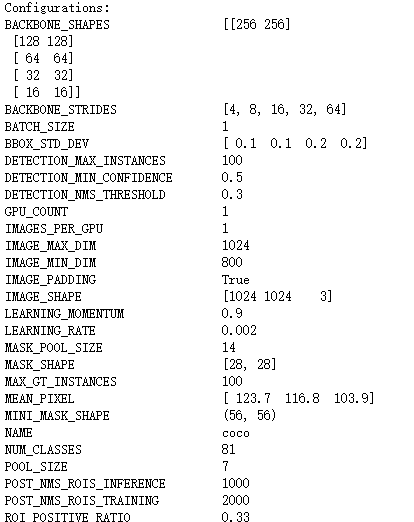
# Device to load the neural network on. # Useful if you're training a model on the same # machine, in which case use CPU and leave the # GPU for training. DEVICE = "/cpu:0" # /cpu:0 or /gpu:0 # Inspect the model in training or inference modes # values: 'inference' or 'training' # TODO: code for 'training' test mode not ready yet TEST_MODE = "inference"
def get_ax(rows=1, cols=1, size=16): """Return a Matplotlib Axes array to be used in all visualizations in the notebook. Provide a central point to control graph sizes. Adjust the size attribute to control how big to render images """ _, ax = plt.subplots(rows, cols, figsize=(size*cols, size*rows)) return ax
# Build validation dataset if config.NAME == 'shapes': dataset = shapes.ShapesDataset() dataset.load_shapes(500, config.IMAGE_SHAPE[0], config.IMAGE_SHAPE[1]) elif config.NAME == "coco": dataset = coco.CocoDataset() dataset.load_coco(COCO_DIR, "minival") # Must call before using the dataset dataset.prepare() print("Images: {} Classes: {}".format(len(dataset.image_ids), dataset.class_names))

# Create model in inference mode with tf.device(DEVICE): model = modellib.MaskRCNN(mode="inference", model_dir=MODEL_DIR, config=config) # Set weights file path if config.NAME == "shapes": weights_path = SHAPES_MODEL_PATH elif config.NAME == "coco": weights_path = COCO_MODEL_PATH # Or, uncomment to load the last model you trained # weights_path = model.find_last()[1] # Load weights print("Loading weights ", weights_path) model.load_weights(weights_path, by_name=True)
image_id = random.choice(dataset.image_ids) image, image_meta, gt_class_id, gt_bbox, gt_mask = modellib.load_image_gt(dataset, config, image_id, use_mini_mask=False) info = dataset.image_info[image_id] print("image ID: {}.{} ({}) {}".format(info["source"], info["id"], image_id, dataset.image_reference(image_id))) # Run object detection results = model.detect([image], verbose=1) # Display results ax = get_ax(1) r = results[0] visualize.display_instances(image, r['rois'], r['masks'], r['class_ids'], dataset.class_names, r['scores'], ax=ax, title="Predictions") log("gt_class_id", gt_class_id) log("gt_bbox", gt_bbox) log("gt_mask", gt_mask)

# Draw precision-recall curve AP, precisions, recalls, overlaps = utils.compute_ap(gt_bbox, gt_class_id, gt_mask, r['rois'], r['class_ids'], r['scores'], r['masks']) visualize.plot_precision_recall(AP, precisions, recalls)
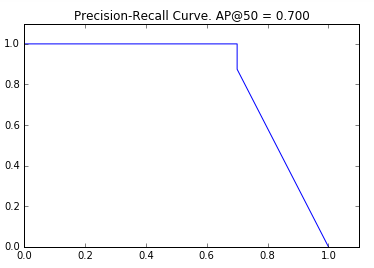
# Grid of ground truth objects and their predictions visualize.plot_overlaps(gt_class_id, r['class_ids'], r['scores'], overlaps, dataset.class_names)

# Compute VOC-style Average Precision def compute_batch_ap(image_ids): APs = [] for image_id in image_ids: # Load image image, image_meta, gt_class_id, gt_bbox, gt_mask = modellib.load_image_gt(dataset, config, image_id, use_mini_mask=False) # Run object detection results = model.detect([image], verbose=0) # Compute AP r = results[0] AP, precisions, recalls, overlaps = utils.compute_ap(gt_bbox, gt_class_id, gt_mask, r['rois'], r['class_ids'], r['scores'], r['masks']) APs.append(AP) return APs # Pick a set of random images image_ids = np.random.choice(dataset.image_ids, 10) APs = compute_batch_ap(image_ids) print("mAP @ IoU=50: ", np.mean(APs))

# Generate RPN trainig targets # target_rpn_match is 1 for positive anchors, -1 for negative anchors # and 0 for neutral anchors. target_rpn_match, target_rpn_bbox = modellib.build_rpn_targets( image.shape, model.anchors, gt_class_id, gt_bbox, model.config) log("target_rpn_match", target_rpn_match) log("target_rpn_bbox", target_rpn_bbox) positive_anchor_ix = np.where(target_rpn_match[:] == 1)[0] negative_anchor_ix = np.where(target_rpn_match[:] == -1)[0] neutral_anchor_ix = np.where(target_rpn_match[:] == 0)[0] positive_anchors = model.anchors[positive_anchor_ix] negative_anchors = model.anchors[negative_anchor_ix] neutral_anchors = model.anchors[neutral_anchor_ix] log("positive_anchors", positive_anchors) log("negative_anchors", negative_anchors) log("neutral anchors", neutral_anchors) # Apply refinement deltas to positive anchors refined_anchors = utils.apply_box_deltas( positive_anchors, target_rpn_bbox[:positive_anchors.shape[0]] * model.config.RPN_BBOX_STD_DEV) log("refined_anchors", refined_anchors, )

# Display positive anchors before refinement (dotted) and # after refinement (solid). visualize.draw_boxes(image, boxes=positive_anchors, refined_boxes=refined_anchors, ax=get_ax())
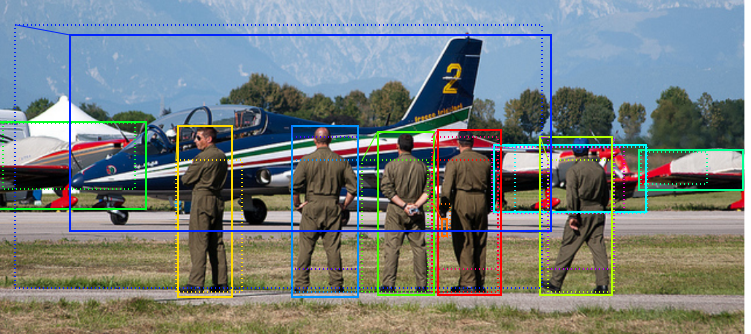
# Run RPN sub-graph pillar = model.keras_model.get_layer("ROI").output # node to start searching from # TF 1.4 introduces a new version of NMS. Search for both names to support TF 1.3 and 1.4 nms_node = model.ancestor(pillar, "ROI/rpn_non_max_suppression:0") if nms_node is None: nms_node = model.ancestor(pillar, "ROI/rpn_non_max_suppression/NonMaxSuppressionV2:0") rpn = model.run_graph([image], [ ("rpn_class", model.keras_model.get_layer("rpn_class").output), ("pre_nms_anchors", model.ancestor(pillar, "ROI/pre_nms_anchors:0")), ("refined_anchors", model.ancestor(pillar, "ROI/refined_anchors:0")), ("refined_anchors_clipped", model.ancestor(pillar, "ROI/refined_anchors_clipped:0")), ("post_nms_anchor_ix", nms_node), ("proposals", model.keras_model.get_layer("ROI").output), ])

# Show top anchors by score (before refinement) limit = 100 sorted_anchor_ids = np.argsort(rpn['rpn_class'][:,:,1].flatten())[::-1] visualize.draw_boxes(image, boxes=model.anchors[sorted_anchor_ids[:limit]], ax=get_ax())

# Show top anchors with refinement. Then with clipping to image boundaries limit = 50 ax = get_ax(1, 2) visualize.draw_boxes(image, boxes=rpn["pre_nms_anchors"][0, :limit], refined_boxes=rpn["refined_anchors"][0, :limit], ax=ax[0]) visualize.draw_boxes(image, refined_boxes=rpn["refined_anchors_clipped"][0, :limit], ax=ax[1])

# Show refined anchors after non-max suppression limit = 50 ixs = rpn["post_nms_anchor_ix"][:limit] visualize.draw_boxes(image, refined_boxes=rpn["refined_anchors_clipped"][0, ixs], ax=get_ax())

# Show final proposals # These are the same as the previous step (refined anchors # after NMS) but with coordinates normalized to [0, 1] range. limit = 50 # Convert back to image coordinates for display h, w = config.IMAGE_SHAPE[:2] proposals = rpn['proposals'][0, :limit] * np.array([h, w, h, w]) visualize.draw_boxes(image, refined_boxes=proposals, ax=get_ax())

# Measure the RPN recall (percent of objects covered by anchors) # Here we measure recall for 3 different methods: # - All anchors # - All refined anchors # - Refined anchors after NMS iou_threshold = 0.7 recall, positive_anchor_ids = utils.compute_recall(model.anchors, gt_bbox, iou_threshold) print("All Anchors ({:5}) Recall: {:.3f} Positive anchors: {}".format( model.anchors.shape[0], recall, len(positive_anchor_ids))) recall, positive_anchor_ids = utils.compute_recall(rpn['refined_anchors'][0], gt_bbox, iou_threshold) print("Refined Anchors ({:5}) Recall: {:.3f} Positive anchors: {}".format( rpn['refined_anchors'].shape[1], recall, len(positive_anchor_ids))) recall, positive_anchor_ids = utils.compute_recall(proposals, gt_bbox, iou_threshold) print("Post NMS Anchors ({:5}) Recall: {:.3f} Positive anchors: {}".format( proposals.shape[0], recall, len(positive_anchor_ids)))

# Get input and output to classifier and mask heads. mrcnn = model.run_graph([image], [ ("proposals", model.keras_model.get_layer("ROI").output), ("probs", model.keras_model.get_layer("mrcnn_class").output), ("deltas", model.keras_model.get_layer("mrcnn_bbox").output), ("masks", model.keras_model.get_layer("mrcnn_mask").output), ("detections", model.keras_model.get_layer("mrcnn_detection").output), ])

# Get detection class IDs. Trim zero padding. det_class_ids = mrcnn['detections'][0, :, 4].astype(np.int32) det_count = np.where(det_class_ids == 0)[0][0] det_class_ids = det_class_ids[:det_count] detections = mrcnn['detections'][0, :det_count] print("{} detections: {}".format( det_count, np.array(dataset.class_names)[det_class_ids])) captions = ["{} {:.3f}".format(dataset.class_names[int(c)], s) if c > 0 else "" for c, s in zip(detections[:, 4], detections[:, 5])] visualize.draw_boxes( image, refined_boxes=detections[:, :4], visibilities=[2] * len(detections), captions=captions, title="Detections", ax=get_ax())
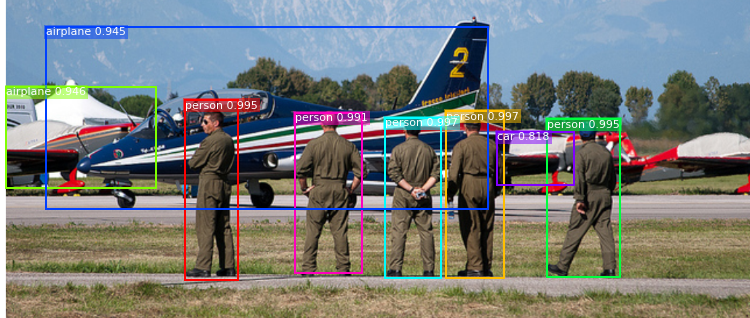
# Proposals are in normalized coordinates. Scale them # to image coordinates. h, w = config.IMAGE_SHAPE[:2] proposals = np.around(mrcnn["proposals"][0] * np.array([h, w, h, w])).astype(np.int32) # Class ID, score, and mask per proposal roi_class_ids = np.argmax(mrcnn["probs"][0], axis=1) roi_scores = mrcnn["probs"][0, np.arange(roi_class_ids.shape[0]), roi_class_ids] roi_class_names = np.array(dataset.class_names)[roi_class_ids] roi_positive_ixs = np.where(roi_class_ids > 0)[0] # How many ROIs vs empty rows? print("{} Valid proposals out of {}".format(np.sum(np.any(proposals, axis=1)), proposals.shape[0])) print("{} Positive ROIs".format(len(roi_positive_ixs))) # Class counts print(list(zip(*np.unique(roi_class_names, return_counts=True))))

# Display a random sample of proposals. # Proposals classified as background are dotted, and # the rest show their class and confidence score. limit = 200 ixs = np.random.randint(0, proposals.shape[0], limit) captions = ["{} {:.3f}".format(dataset.class_names[c], s) if c > 0 else "" for c, s in zip(roi_class_ids[ixs], roi_scores[ixs])] visualize.draw_boxes(image, boxes=proposals[ixs], visibilities=np.where(roi_class_ids[ixs] > 0, 2, 1), captions=captions, title="ROIs Before Refinement", ax=get_ax())

# Class-specific bounding box shifts. roi_bbox_specific = mrcnn["deltas"][0, np.arange(proposals.shape[0]), roi_class_ids] log("roi_bbox_specific", roi_bbox_specific) # Apply bounding box transformations # Shape: [N, (y1, x1, y2, x2)] refined_proposals = utils.apply_box_deltas( proposals, roi_bbox_specific * config.BBOX_STD_DEV).astype(np.int32) log("refined_proposals", refined_proposals) # Show positive proposals # ids = np.arange(roi_boxes.shape[0]) # Display all limit = 5 ids = np.random.randint(0, len(roi_positive_ixs), limit) # Display random sample captions = ["{} {:.3f}".format(dataset.class_names[c], s) if c > 0 else "" for c, s in zip(roi_class_ids[roi_positive_ixs][ids], roi_scores[roi_positive_ixs][ids])] visualize.draw_boxes(image, boxes=proposals[roi_positive_ixs][ids], refined_boxes=refined_proposals[roi_positive_ixs][ids], visibilities=np.where(roi_class_ids[roi_positive_ixs][ids] > 0, 1, 0), captions=captions, title="ROIs After Refinement", ax=get_ax())

# Remove boxes classified as background keep = np.where(roi_class_ids > 0)[0] print("Keep {} detections: {}".format(keep.shape[0], keep))

# Remove low confidence detections keep = np.intersect1d(keep, np.where(roi_scores >= config.DETECTION_MIN_CONFIDENCE)[0]) print("Remove boxes below {} confidence. Keep {}: {}".format( config.DETECTION_MIN_CONFIDENCE, keep.shape[0], keep))

# Apply per-class non-max suppression pre_nms_boxes = refined_proposals[keep] pre_nms_scores = roi_scores[keep] pre_nms_class_ids = roi_class_ids[keep] nms_keep = [] for class_id in np.unique(pre_nms_class_ids): # Pick detections of this class ixs = np.where(pre_nms_class_ids == class_id)[0] # Apply NMS class_keep = utils.non_max_suppression(pre_nms_boxes[ixs], pre_nms_scores[ixs], config.DETECTION_NMS_THRESHOLD) # Map indicies class_keep = keep[ixs[class_keep]] nms_keep = np.union1d(nms_keep, class_keep) print("{:22}: {} -> {}".format(dataset.class_names[class_id][:20], keep[ixs], class_keep)) keep = np.intersect1d(keep, nms_keep).astype(np.int32) print(" Kept after per-class NMS: {} {}".format(keep.shape[0], keep))

# Show final detections ixs = np.arange(len(keep)) # Display all # ixs = np.random.randint(0, len(keep), 10) # Display random sample captions = ["{} {:.3f}".format(dataset.class_names[c], s) if c > 0 else "" for c, s in zip(roi_class_ids[keep][ixs], roi_scores[keep][ixs])] visualize.draw_boxes( image, boxes=proposals[keep][ixs], refined_boxes=refined_proposals[keep][ixs], visibilities=np.where(roi_class_ids[keep][ixs] > 0, 1, 0), captions=captions, title="Detections after NMS", ax=get_ax())

display_images(np.transpose(gt_mask, [2, 0, 1]), cmap="Blues")
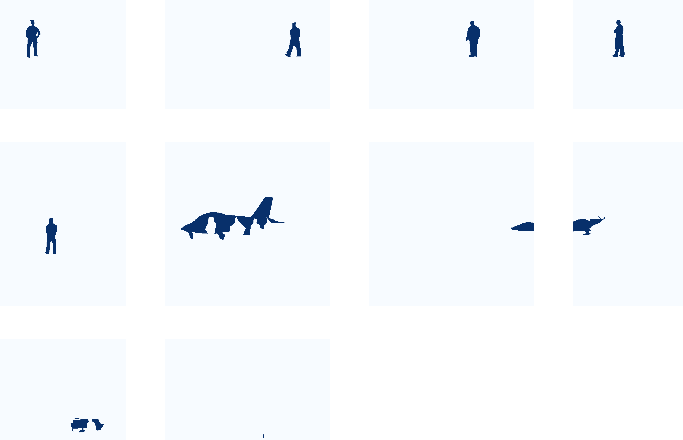
# Get predictions of mask head mrcnn = model.run_graph([image], [ ("detections", model.keras_model.get_layer("mrcnn_detection").output), ("masks", model.keras_model.get_layer("mrcnn_mask").output), ]) # Get detection class IDs. Trim zero padding. det_class_ids = mrcnn['detections'][0, :, 4].astype(np.int32) det_count = np.where(det_class_ids == 0)[0][0] det_class_ids = det_class_ids[:det_count] print("{} detections: {}".format( det_count, np.array(dataset.class_names)[det_class_ids]))

# Masks det_boxes = mrcnn["detections"][0, :, :4].astype(np.int32) det_mask_specific = np.array([mrcnn["masks"][0, i, :, :, c] for i, c in enumerate(det_class_ids)]) det_masks = np.array([utils.unmold_mask(m, det_boxes[i], image.shape) for i, m in enumerate(det_mask_specific)]) log("det_mask_specific", det_mask_specific) log("det_masks", det_masks)

display_images(det_mask_specific[:4] * 255, cmap="Blues", interpolation="none")

display_images(det_masks[:4] * 255, cmap="Blues", interpolation="none")

# Get activations of a few sample layers activations = model.run_graph([image], [ ("input_image", model.keras_model.get_layer("input_image").output), ("res4w_out", model.keras_model.get_layer("res4w_out").output), # for resnet100 ("rpn_bbox", model.keras_model.get_layer("rpn_bbox").output), ("roi", model.keras_model.get_layer("ROI").output), ])

# Input image (normalized) _ = plt.imshow(modellib.unmold_image(activations["input_image"][0],config))

# Backbone feature map display_images(np.transpose(activations["res4w_out"][0,:,:,:4], [2, 0, 1]))

# Histograms of RPN bounding box deltas plt.figure(figsize=(12, 3)) plt.subplot(1, 4, 1) plt.title("dy") _ = plt.hist(activations["rpn_bbox"][0,:,0], 50) plt.subplot(1, 4, 2) plt.title("dx") _ = plt.hist(activations["rpn_bbox"][0,:,1], 50) plt.subplot(1, 4, 3) plt.title("dw") _ = plt.hist(activations["rpn_bbox"][0,:,2], 50) plt.subplot(1, 4, 4) plt.title("dh") _ = plt.hist(activations["rpn_bbox"][0,:,3], 50)

# Distribution of y, x coordinates of generated proposals plt.figure(figsize=(10, 5)) plt.subplot(1, 2, 1) plt.title("y1, x1") plt.scatter(activations["roi"][0,:,0], activations["roi"][0,:,1]) plt.subplot(1, 2, 2) plt.title("y2, x2") plt.scatter(activations["roi"][0,:,2], activations["roi"][0,:,3]) plt.show()
